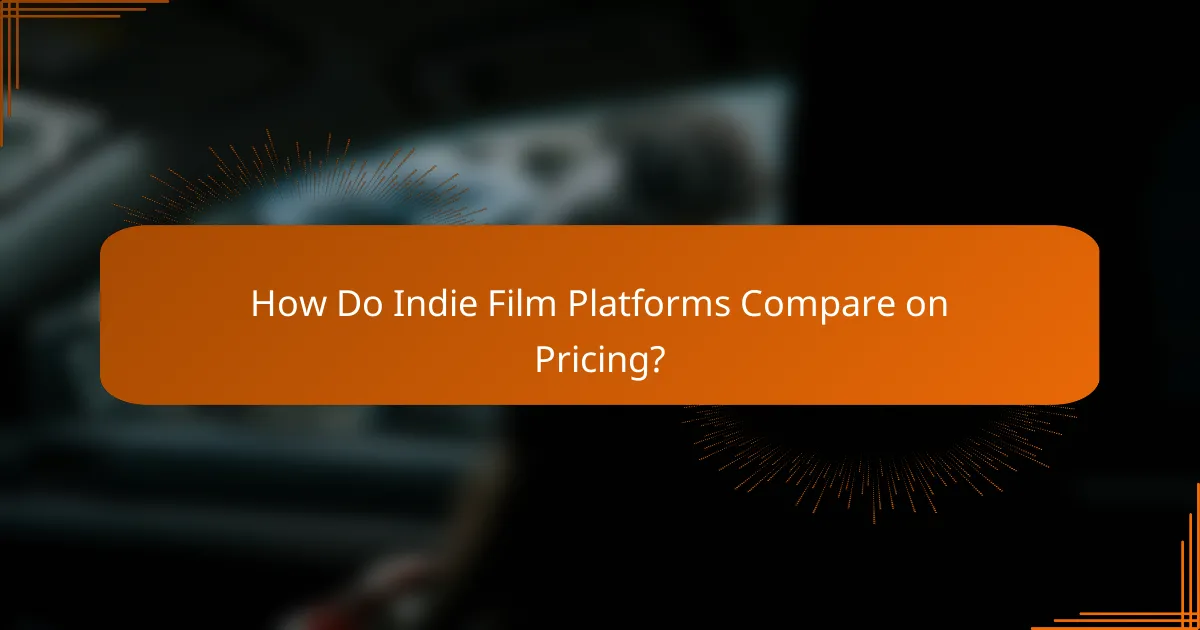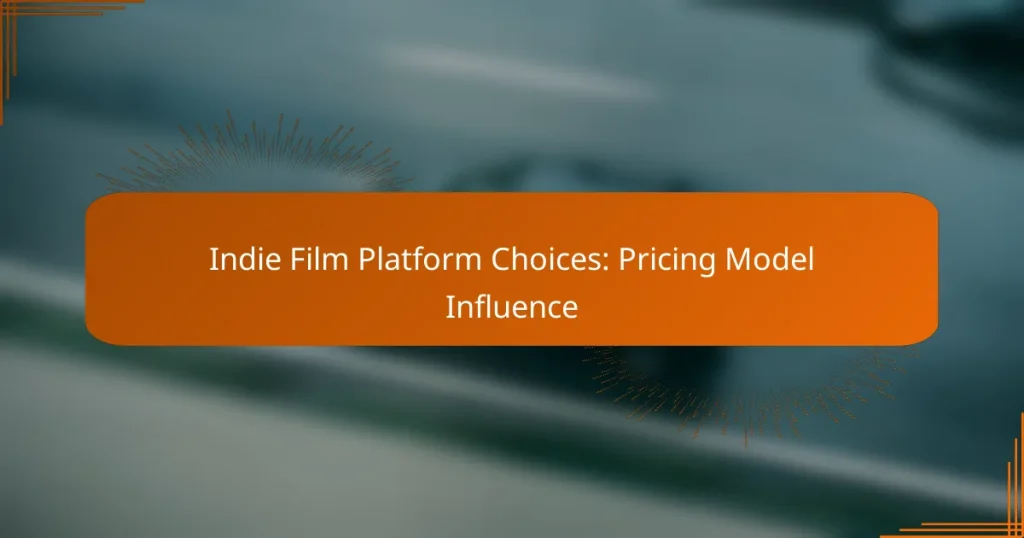Choosing the right indie film platform is crucial for filmmakers, as various pricing models and distribution options can greatly influence visibility, revenue, and audience engagement. The pricing structure not only affects how filmmakers earn revenue but also determines how audiences access content, shaping the platform’s overall profitability. By carefully evaluating features that enhance distribution and marketing, filmmakers can significantly improve their film’s success and reach.

What Are the Best Indie Film Platforms for Filmmakers?
The best indie film platforms for filmmakers offer various pricing models and distribution options that cater to different needs. Choosing the right platform can significantly impact visibility, revenue, and audience engagement.
Vimeo On Demand
Vimeo On Demand allows filmmakers to sell or rent their films directly to audiences. Creators can set their own prices and retain 90% of the revenue after transaction fees, making it a lucrative option for independent filmmakers.
Filmmakers should consider the platform’s user-friendly interface and customizable player, which enhances viewer experience. However, competition can be stiff, so effective marketing strategies are essential to drive traffic to your film.
FilmFreeway
FilmFreeway is primarily a submission platform for film festivals, but it also offers a marketplace for filmmakers to showcase their work. It is free to use, with filmmakers only paying submission fees to festivals.
This platform is ideal for those looking to gain exposure through festivals. Filmmakers should focus on crafting compelling festival applications and leveraging the platform’s networking opportunities to connect with industry professionals.
IndieFlix
IndieFlix is a subscription-based streaming service that features independent films. Filmmakers receive royalties based on the number of views their films attract, providing a steady income stream.
To succeed on IndieFlix, filmmakers should ensure their content is engaging and aligns with the platform’s audience preferences. Regularly promoting their films through social media can help increase viewership and, consequently, earnings.
Amazon Prime Video Direct
Amazon Prime Video Direct enables filmmakers to distribute their films to a vast audience on Amazon. Filmmakers can choose between a revenue share model or a one-time payment option, giving flexibility in monetization strategies.
While the potential for high visibility is significant, filmmakers must adhere to Amazon’s content guidelines and invest in marketing to stand out among the millions of titles available. Regularly updating promotional materials can enhance visibility.
Seed&Spark
Seed&Spark is a crowdfunding platform that also offers distribution services for indie films. Filmmakers can raise funds while building an audience, which is crucial for successful project launches.
Utilizing Seed&Spark effectively involves engaging with backers and creating a strong community around the project. Filmmakers should focus on storytelling and transparency to foster trust and encourage support from potential viewers and investors.

How Do Pricing Models Affect Indie Film Platforms?
Pricing models significantly influence indie film platforms by determining how filmmakers earn revenue and how audiences access content. Different models can attract diverse user bases and affect the overall profitability and sustainability of the platform.
Subscription-based pricing
Subscription-based pricing allows users to pay a recurring fee, typically monthly or annually, for access to a library of films. This model can create a steady revenue stream for indie platforms while providing viewers with a wide selection of content for a predictable cost.
Filmmakers benefit from this model as they receive a share of the subscription revenue based on viewership metrics. However, platforms must ensure a consistent influx of new content to keep subscribers engaged and reduce churn rates.
Revenue sharing models
Revenue sharing models involve splitting the income generated from film rentals or purchases between the platform and the filmmakers. This approach can be advantageous for indie filmmakers, as they only pay fees when their films generate income.
Platforms typically take a percentage of the revenue, which can range from low to high depending on the service. Filmmakers should consider the platform’s audience reach and marketing support when choosing this model, as it can significantly impact their earnings.
Flat fee options
Flat fee options require filmmakers to pay a one-time fee to host their films on a platform, regardless of how many views or rentals they receive. This model can be appealing for filmmakers who prefer upfront costs and want to retain full control over their earnings.
However, the risk lies in the potential for low viewership, which may not justify the initial investment. Filmmakers should evaluate the platform’s audience and promotional capabilities to ensure that their films will reach a sufficient number of viewers to make this model worthwhile.

What Are the Key Features to Consider in Indie Film Platforms?
When choosing an indie film platform, consider features that enhance distribution, marketing, and user experience. These elements can significantly impact the visibility and success of your film.
Distribution reach
Distribution reach refers to how widely your film can be accessed by audiences. Platforms vary in their ability to distribute films across different regions and channels, including streaming services, theaters, and festivals.
Look for platforms that have partnerships with major streaming services or established distribution networks. A platform with a broad reach can help your film gain exposure in multiple markets, increasing potential viewership and revenue.
Marketing tools
Effective marketing tools are essential for promoting your indie film. Many platforms offer features such as social media integration, email marketing, and analytics to track engagement.
Consider platforms that provide customizable promotional materials and audience targeting options. These tools can help you reach the right viewers and maximize your film’s visibility, which is crucial for indie projects with limited budgets.
User experience
User experience encompasses how easily viewers can navigate the platform and access your film. A well-designed interface can enhance viewer satisfaction and retention.
Choose platforms that prioritize intuitive navigation, quick loading times, and mobile compatibility. A positive user experience can lead to higher engagement rates and encourage viewers to explore more of your content.

How Do Indie Film Platforms Compare on Pricing?
Indie film platforms vary significantly in their pricing models, impacting how filmmakers earn revenue. Understanding these differences is crucial for selecting the right platform for distribution and maximizing potential earnings.
Vimeo On Demand pricing
Vimeo On Demand operates on a revenue-sharing model where creators set their own prices for rentals or purchases. Vimeo takes a commission of around 10% on sales, meaning filmmakers retain approximately 90% of the revenue. This model allows for flexibility in pricing, enabling creators to adjust based on audience response.
Filmmakers can also choose to offer discounts or bundle their films, which can attract more viewers. However, it’s essential to consider the platform’s audience and marketing tools to effectively promote the film.
Amazon Prime Video Direct fees
Amazon Prime Video Direct has a more complex pricing structure, primarily based on a revenue share model. Filmmakers can earn between 50% to 70% of the net revenue, depending on the distribution method chosen. For example, if a film is included in the Prime subscription, earnings are based on the number of hours streamed.
Additionally, there are costs associated with delivering content, such as encoding fees and potential promotional expenses. Filmmakers should weigh these factors against the platform’s vast audience reach when deciding on Amazon as a distribution option.
Seed&Spark pricing structure
Seed&Spark utilizes a unique crowdfunding and distribution model, charging a 5% fee on funds raised through its platform. This fee applies to both crowdfunding campaigns and any subsequent sales made through their distribution service. Filmmakers can also offer their films for free or set a price, allowing for flexible monetization strategies.
Moreover, Seed&Spark provides tools for audience engagement and marketing, which can enhance a film’s visibility. Filmmakers should consider how these features align with their goals and whether the lower fee structure is beneficial compared to other platforms.

What Are the Pros and Cons of Each Indie Film Platform?
Each indie film platform offers distinct advantages and disadvantages that can significantly impact filmmakers’ choices. Understanding these factors helps creators select the best fit for their distribution and monetization needs.
Vimeo On Demand advantages
Vimeo On Demand provides filmmakers with a user-friendly platform that allows for direct sales to audiences. Creators can set their own pricing, which typically ranges from $1 to $20, giving them control over revenue generation.
Additionally, Vimeo offers high-quality video playback and customizable storefronts, enhancing the viewing experience. The platform also supports various promotional tools, such as discount codes and pre-orders, which can boost sales and engagement.
FilmFreeway disadvantages
FilmFreeway primarily serves as a submission platform for film festivals rather than a direct distribution service, which can limit its utility for filmmakers seeking to monetize their work. While it offers free submissions to many festivals, filmmakers may face fees for premium festivals, which can add up.
Moreover, the lack of a built-in monetization feature means filmmakers must seek alternative platforms for revenue. This can complicate the distribution process and require additional effort to manage multiple platforms.
IndieFlix unique benefits
IndieFlix stands out by focusing on independent films and providing a subscription-based model that benefits both filmmakers and viewers. Filmmakers receive a share of subscription revenue, which can provide ongoing income as their films gain traction.
The platform also emphasizes community engagement, allowing filmmakers to connect with audiences through Q&A sessions and discussions. This interaction can enhance visibility and foster a loyal viewer base, making it a valuable option for indie filmmakers.

How Do Filmmakers Choose the Right Platform?
Filmmakers select the right platform based on factors like audience reach, pricing models, and distribution options. Understanding these elements helps ensure their work is effectively showcased and monetized.
Consider Audience Reach
Audience reach is crucial when choosing a platform. Filmmakers should evaluate where their target demographic spends time, whether it’s on streaming services, social media, or niche platforms. For instance, platforms like Vimeo may cater to independent filmmakers seeking a creative community, while larger services like Amazon Prime offer broader visibility.
Evaluate Pricing Models
Different platforms employ various pricing models, including subscription-based, pay-per-view, or ad-supported options. Filmmakers must assess which model aligns with their financial goals and audience expectations. A pay-per-view model might yield higher revenue for a niche film, while a subscription service could provide steady income over time.
Analyze Distribution Options
Distribution options vary significantly across platforms. Some platforms allow filmmakers to retain rights and control over their work, while others may require exclusivity. Understanding these terms is essential; for example, a filmmaker might prefer a non-exclusive deal to maximize exposure across multiple platforms.
Review Support and Resources
Support and resources offered by a platform can influence a filmmaker’s choice. Platforms that provide marketing assistance, analytics, or community engagement tools can enhance a film’s success. Filmmakers should look for platforms that not only host their work but also actively support its promotion.


